This step by step diy woodworking project is about diy reloading bench plans. The project features instructions for building a basic reloading bench with a hutch, using common materials and tools. Make sure you take a look over the rest of the related projects to see alternatives and more projects for hunting, as well as for your backyard.
When buying the lumber, you should select the planks with great care, making sure they are straight and without any visible flaws (cracks, knots, twists, decay). Investing in cedar or other weather resistant lumber is a good idea, as it will pay off on the long run. Use a spirit level to plumb and align the components, before inserting the galvanized screws, otherwise the project won’t have a symmetrical look. If you have all the materials and tools required for the project, you could get the job done in about a day. See all my Premium Plans HERE.
Projects made from these plans
DIY Reloading Bench Plans
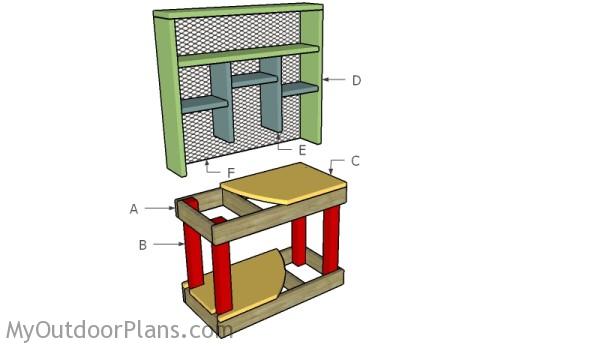
Building a reloading bench
Cut List
- A – 4 pieces of 2×6 lumber – 21″ long, 2 pieces – 48″ long 2xFRAME
- B – 4 pieces of 4×4 lumber – 36″ long LEGS
- C – 4 pieces of 3/4″ plywood – 24″x48″ long BOTTOM
- D – 2 pieces of 2×10 lumber – 43″ long, 1 piece – 51″ long, 1 piece – 48″ long HUTCH
- E – 2 pieces of 2×10 lumber – 23 1/2″ long, 2 pieces – 14 1/2 ” long, 1 piece – 16″ long PARTITIONS
- F – 1 piece – 44 1/2″x51″ long PEGBOARD
Shopping List
- 4 pieces of 2×6 lumber – 8 ft
- 1 piece of 4×4 lumber – 12 ft
- 1 piece of 3/4″ plywood – 4’x8′
- 3 pieces of 2×10 lumber – 10 ft
- 1 1/4″ screws
- 1 5/8″ screws
- 2 1/2″ screws
- filler, stain
- glue
Tools
![]() Hammer, Tape measure, Framing square, Level
Hammer, Tape measure, Framing square, Level
![]() Miter saw, Drill machinery, Screwdriver, Sander
Miter saw, Drill machinery, Screwdriver, Sander
Time
![]() One day
One day
How to build a reloading bench

Building the frames
The first step of the project is to build the frame for the reloading bench. Cut the components from 2×6 lumber at the dimensions shown in the plans. Drill pilot holes through the rim components and insert 2 1/2″ screws into the perpendicular components. Check if the corners are square and align the edges.
Alternatively, if you see this as overbuilt, you can use 2×4 lumber for the frame.
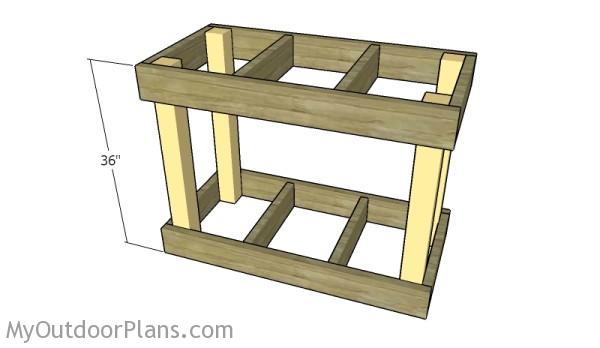
Attaching the legs to the frames
After building the two frames for the reloading bench, you should attach the 4×4 legs. Drill pilot holes through the frame and insert 2 1/2″ screws into legs, after making sure the corners are square.
Remember that you can leave about 2″ from the floor to the bottom frame, if you like that more.

Building the countertops
Build the countertops from 3/4″ plywood using the information from the plans. Make the notches with a jigsaw. Smooth the cut edges with sandpaper. This plans features 1 1/2″ thick countertops, so you could glue together two sheets of plywood. However, you should remember that you can use just one sheet for the reloading bench.

Fitting the countertops
Lay the countertops to the frame of the reloading bench and align the edges with attention. Use 2 1/2″ finishing nails and glue to the secure the panels into place. Smooth the edges with sandpaper and remove the residues with a damp cloth.
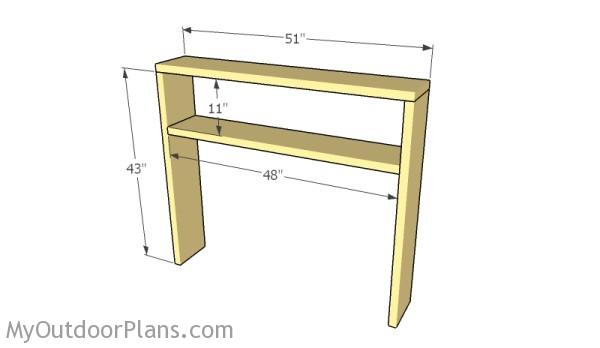
Assembling the frame of the hutch
Next, you should build the frame for the hutch. Use 2×10 slats to build the hutch for the reloading bench. Drill pilot holes through the slats and insert 2 1/2″ screws to secure everything together tightly. Make sure the edges are aligned and check if the corners are square.
Remember that you can use 1×10 slats for the hutch, id you want to decrease the costs and build a light frame. If you use 1×10 slats, make sure you insert 1 1/4″ screws.
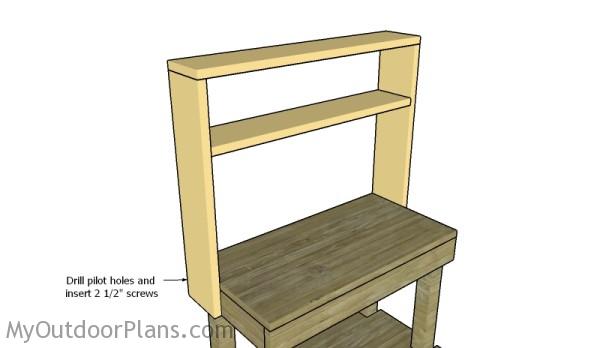
Building the frame of the hutch
Fit the hutch to the reloading bench, as shown in the diagram. Drill pilot holes through the vertical supports and insert 2 1/2″ screws into the frame of the bench. Use a spirit level to plumb the hutch and leave no gaps between the components. Use four screws on both sides of the hutch for a proper bond.
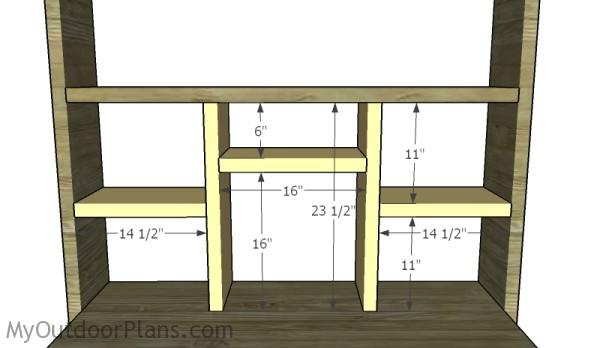
Fitting the partitions
Next, you need to install the partitions to the wooden hutch. The easiest way to secure the slats to the frame of the hutch is by drilling pocket holes at both ends of the slats. Fit the components into place and secure them to the frame using 1 1/4″ galvanized screws.
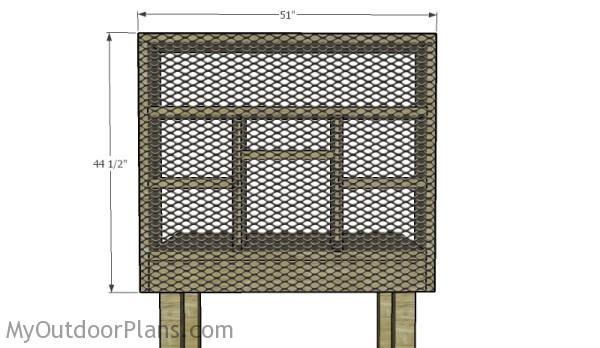
Attaching the pegboard
One of the last steps of the project is to attach a pegboard to the back of the hutch. Use 1 1/4″ screws to secure the pegboard to the frame of the hutch.
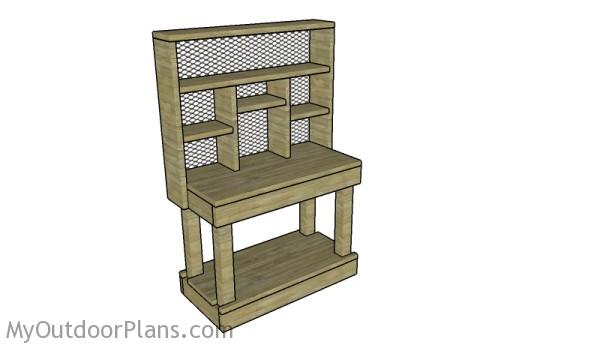
Reloading Bench Plans
Fill the holes and dents with wood putty and let it dry out for several hours. Use 120-200 grit sandpaper to smooth the surface. Remember that you can adjust the design of the reloading bench to suit your needs.
Top Tip: If you want to enhance the look of the project and to protect the components from decay, we recommend you to apply paint or stain.
This woodworking project was about diy reloading bench plans. If you want to see more outdoor plans, we recommend you to check out the rest of our step by step projects. LIKE us on Facebook and Google + to be the first that gets out latest projects and to hep us keep adding free woodworking plans for you

4 comments
cant for the life of me figure out where the 2×8 goes.
Sorry, I’ve updated the list
Why did you say to attach the legs before I put the bottom shelf on. Now I can’t put it on. Wtf
You can split the bottom shelf in two pieces and attach it to the frame. Don’t make such a big deal. Anyway, fitting the shelf before the legs is not a great idea.